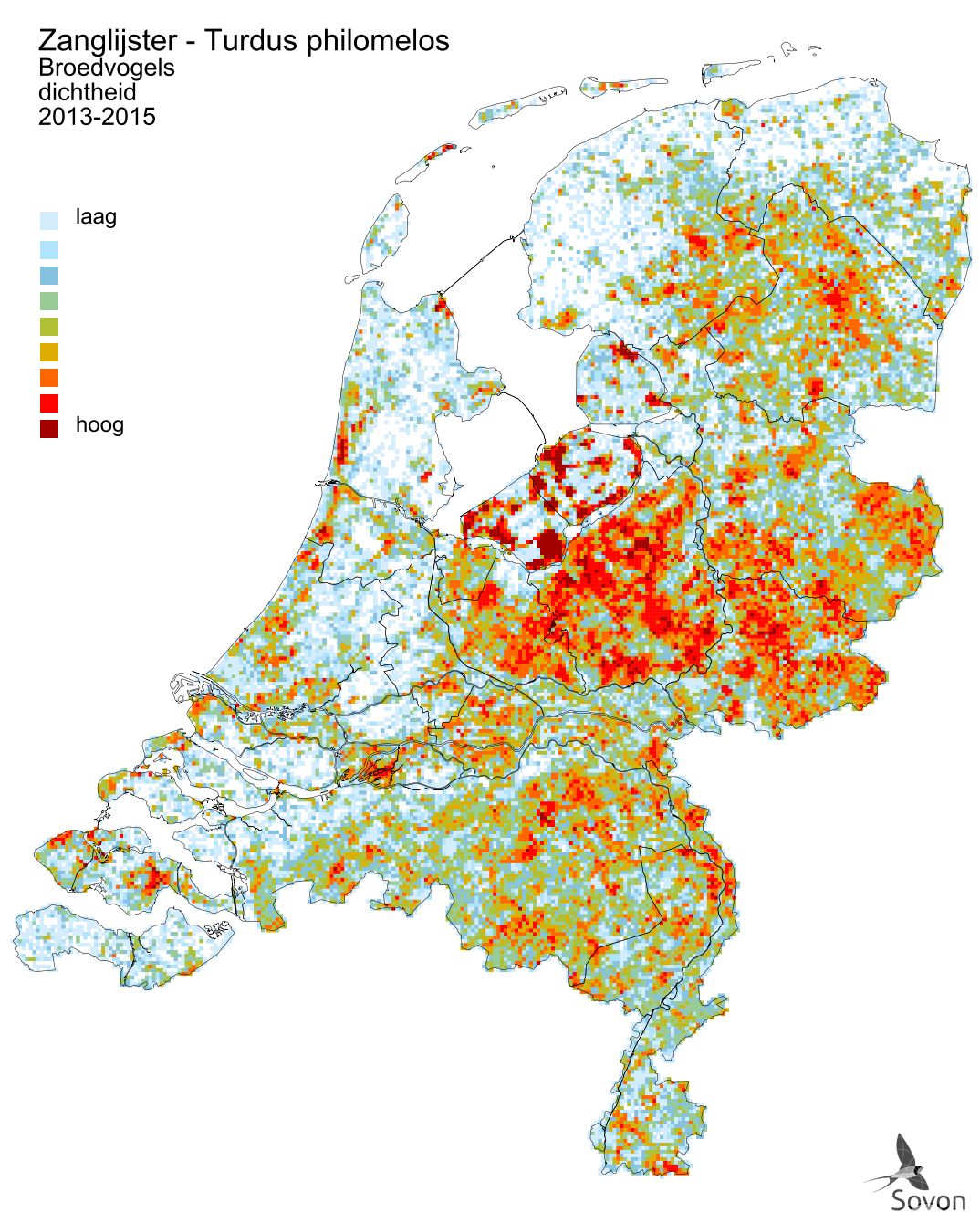Distribution and trends
Distribution

This map is derived from the Bird Atlas of the Netherlands (Sovon 2018). Shown is the relative density of breeding pairs per square kilometer.

Data derived from point-transect-counts in december. Shown is the number of birds along each transect of 20 census points. Zero-values are shown separately.
Population trends
breeding bird trend
Data derived from the common breeding bird census. Shown are annual population indices, derived from national surveys of sample plots (red dots) and the trendline (dark line). Data from 1984-1989 can be less reliable.
- vanaf 1990
- significant increase, < 5% a year (+)
- laatste 12 jaar
- significant increase, < 5% a year (+)
non-breeding bird trend
Data derived from point-transect-counts in december. Shown is the annual population index (with standard error), calculated over about 500 transects with each 20 point-counts.
- vanaf 1980
- significant decrease, <5% a year (-)
- laatste 12 jaar
- no significant change in numbers (0)
Breeding success and survival
adult survival
This graph is based on the Constant Effort Site project (CES). It shows the annual local survival of adult birds (with 95% confidence interval).
Seasonal occurrence
seasonal pattern
This chart is based on LiveAtlas. The reporting frequency per decade is shown, averaged over the last 5 years. The reporting frequency is the percentage of complete lists on which the species is registered.
laying start
This graph is based on the Nest Record Scheme. The average annual date of laying of the first egg is shown (with 95% confidence interval).
Occurrence description
Buiten broedtijd
In het westen en uiterste zuiden van het land overwinteren redelijke aantallen Zanglijsters, waarschijnlijk voor een deel eigen broedvogels. Ze houden zich graag op in parken en tuinen in stedelijk gebied. Elders in het land zijn overwinteraars minder gewoon. De voorjaarstrek speelt zich af tussen eind februari en begin mei; de meeste trek wordt eind maart en begin april vastgesteld. De aantallen zijn tijdens de najaarstrek tussen eind september en eind oktober echter veel hoger. In de kuststrook, maar soms ook in het binnenland, kunnen begin of half oktober meer dan 1000 Zanglijsters per dag passeren en zoeken groepjes overal in geschikte terreinen naar voedsel.
Broedtijd
Zanglijsters broeden bijna overal waar voldoende bomen en struiken aanwezig zijn. De dichtheden zijn nergens zo hoog als in gevarieerd loofbos, jonge aanplant en groene stadswijken. Streng winterweer dat tot in Zuid-Europa doordringt zorgt voor inzinkingen in de landelijke stand, zoals het geval was rond 1985. Series van zachtere winters zorgen voor een snel herstel. Op de langere termijn gerekend zijn de landelijke aantallen toegenomen. Landelijk is de stand stabiel, maar lokaal in delen van de hogere zandgronden nam de soort echter af.
Birds directive
Conservation status
The Birds Directive focuses on the conservation of all naturally occurring wild bird species in Europe, including the Song Thrush.
This means that EU Member States must take measures to maintain or bring the populations of these species to a level that corresponds in particular to ecological, scientific and cultural requirements.
The Birds Directive requires Member States to maintain habitats for birds of sufficient size and quality, including through the designation of Special Protection Areas for the benefit of the European Natura 2000 network. No special protection zones have been designated for the Song Thrush in the Netherlands. The national population must be able to maintain itself at a favorable level.
What is the methodology to assess the conservation status of birds
breeding bird
The conservation status of the Song Thrush as breeding bird in the Netherlands is favourable.
| State of Conservation Assessment | ||||
| Distribution | Population | Habitat | Future | Final verdict |
| favourable | favourable | favourable | favourable | favourable |
non-breeding bird
The conservation status of the Song Thrush as non-breeding bird in the Netherlands is unfavourable (bad).
| State of Conservation Assessment | ||||
| Distribution | Population | Habitat | Future | Final verdict |
| favourable | unfavourable (bad) | favourable | unfavourable (bad) | unfavourable (bad) |
Assigned areas
No areas assigned
Counting guidelines
Broedvogels
Methode
Territoriumkartering
Tijd van het jaar
Half February t/m eind June
Tijd van de dag
Vooral in vroege ochtend (rond zonsopkomst) en avond (zonsondergang).
Datumgrenzen, normbezoeken en fusieafstand
| Valid sightings | normbezoeken | minimaal vereist | fusie- | |||||||||
| adult | paar | terr | nest | migrant | 1 | 2 | 3 | seizoen | datumg | datumgrens | afstand | |
| . | . | X | X | 1-12 | 13+ | 1 | 15-4 t/m 25-6 | 300 | ||||
Aanwijzingen
Zang [broedcode 2] (meestal uit boomtop) en aanwijzingen voor nest: nestbouw [brc 9] (ook: verzamelen van modder, voor komwand), alarm [brc 7] (schetterend hoog geluid), transport van voedsel of uitwerpselpakketje [brc 14] (beide partners).
LET OP: massale zang veelal alleen gedurende korte periode rond zonsopkomst of zonsondergang. Korte snelle telronde dan effectief. Vogels die ’s avonds zingen, verplaatsen zich wellicht wat meer dan die in de ochtendzangers.
Doortrek tot begin mei, maar doortrekkers zingen doorgaans niet, houden zich op in kleine groepjes en vaak buiten bos of andere broedbiotopen.
Broedbiologie
Broedt in bossen, parken, grote tuinen en kleinschalig agrarisch cultuurlandschap. Eileg van begin april tot begin juli, met pieken half april-half mei en juni. Twee broedsels per jaar, meestal 4-5 eieren, broedduur 12-14 dagen, nestjongenperiode 13-14 dagen, uitgevlogen jongen worden nog circa 2 weken gevoerd.
